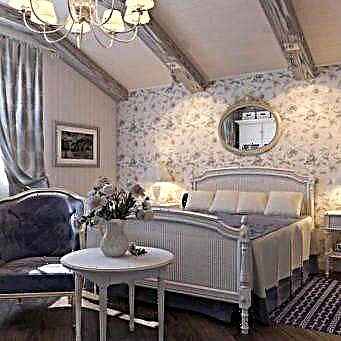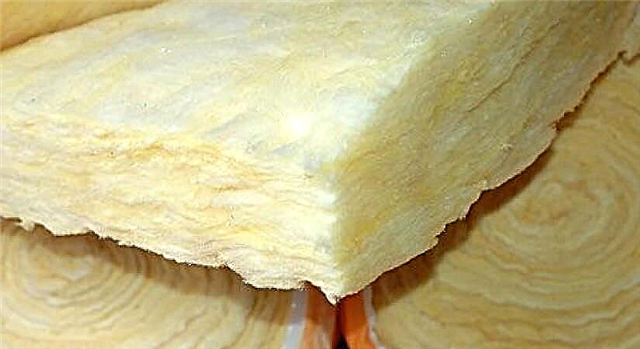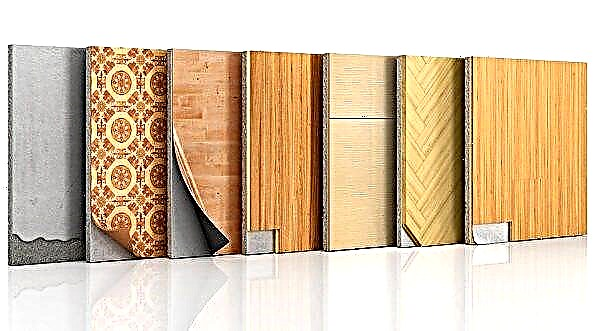The bedroom is the only secluded corner in the house where peace truly rules the atmosphere. A lot of taste solutions apply to the design of the room, but the basis should be cosiness and harmony.
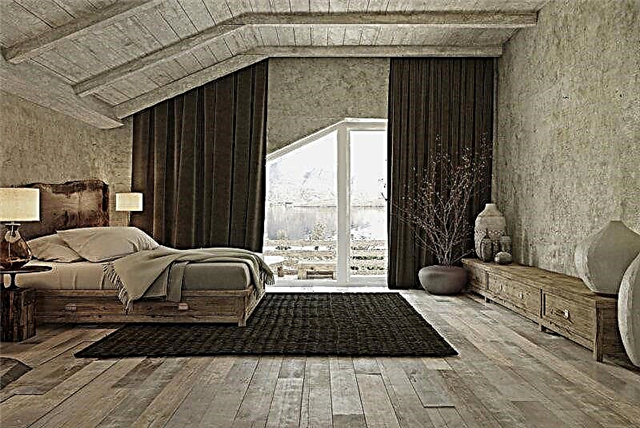
The bedroom in the Japanese style is the standard of the skillful combination of practicality on the verge of asceticism and the logical completeness of the interior. There are no inappropriate details in the setting, every feature is thought out and carries a philosophical meaning.

The free space inherent in the style is filled with air, where energy circulates easily, as in nature itself. After a tiring day, you can hardly find a place to relax and restore lost strength better than the Japanese bedroom.
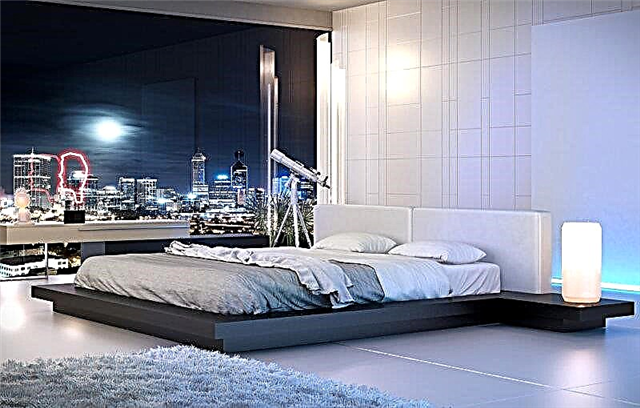
Japanese style basics
Different climatic conditions and layouts of residential premises between the CIS countries and Japan do not allow achieving 100% authenticity in the execution of the interior.
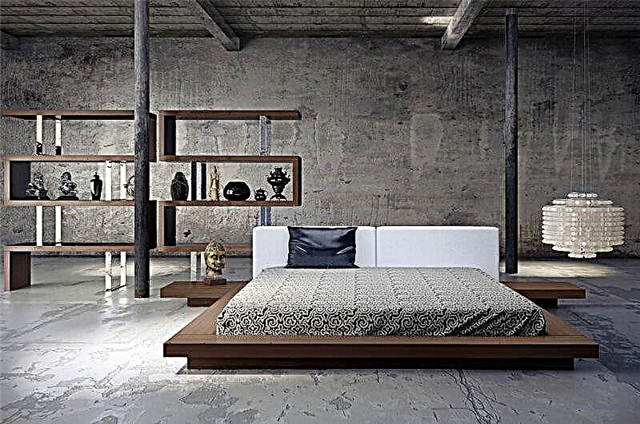
But compliance with the four basic rules that lie in the creation of the Japanese style will make it possible to bring the bedroom as close as possible to the Eastern philosophy of comfort.

Minimalism is only necessary and nothing more. Style will not tolerate massive and useless things that in vain clutter up space.
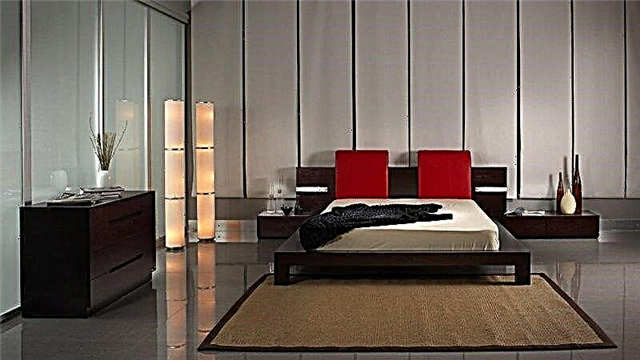
Functionality is a branch of minimalism. Each element of the interior is beneficial, otherwise it does not belong here. It is customary to keep a chest in the bedroom, where the mattress is folded after sleep. The cabinet is small, for the most important things, adapted to the design of the room and not visible to the eye. An abundant amount of lighting is welcome.
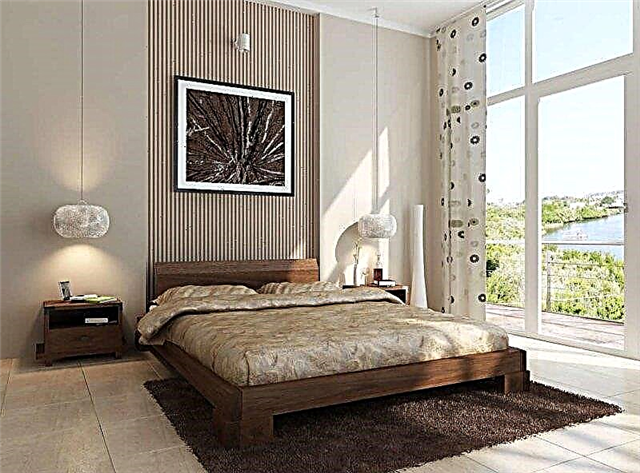
Natural, natural materials - from beginning to end, the decor is created exclusively from natural raw materials, whether it is decoration, furniture or textiles.
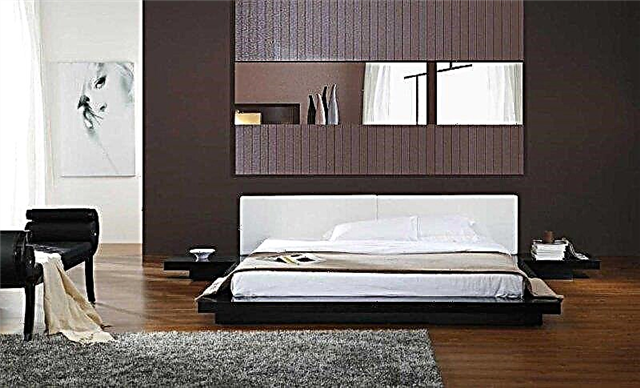
Compactness - the ability to instantly and seamlessly transform a room by moving furniture. This condition is carefully observed in the apartments of Japan, since they are not inclined to differ in large footage. If necessary, the bedroom becomes a living room or dining room.
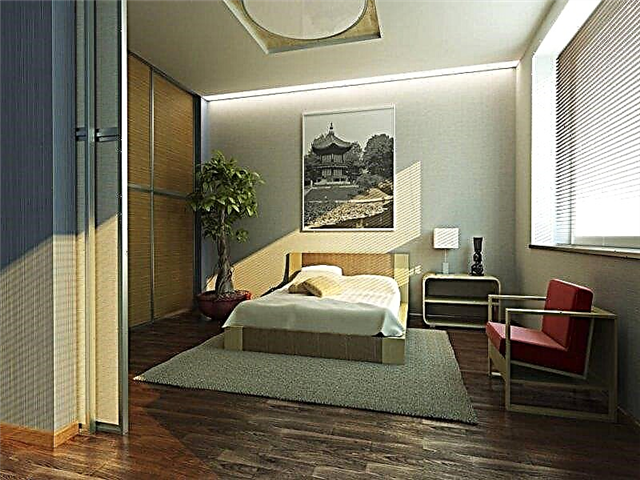
Preferred colors
The authentic design of the Japanese bedroom does not welcome the dominance of colorful, aggressive, and vibrant colors. Soft natural shades are the foundation of the style. It is appropriate to use a white, sand, cream or gray tone.
When arranging a bedroom, they prefer one color and all the decor elements subordinate it to shades. For example, black or several other more catchy for contrast with the main prevailing tone, the main thing is not to overdo it with the quantity.
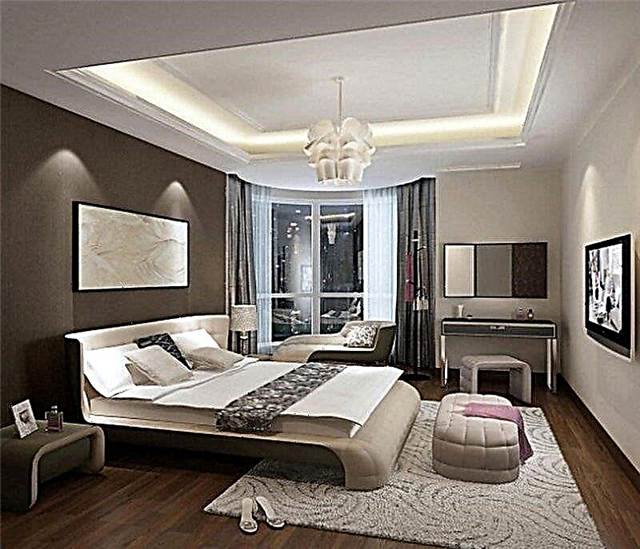
However, if desired, as shown by the photos of Japanese bedrooms in our selection, you can achieve very harmonious and elegant color combinations that are as close as possible to the oriental style.
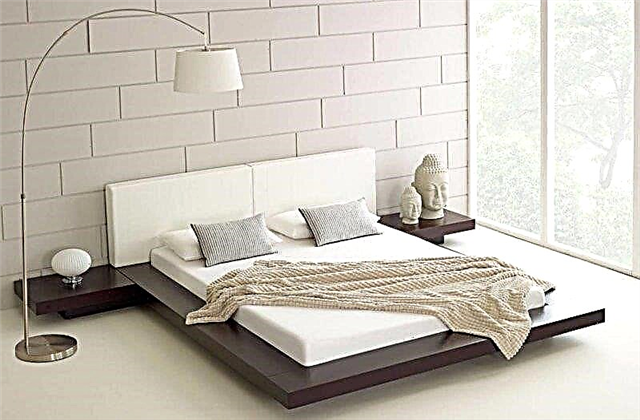
Bedroom Interior
The walls look very stylish if you use wood panels or wallpapers similar to bamboo. Painting with Japanese ornaments or hieroglyphs is welcome, but before that it is important to study their meanings. The walls look fresh, covered with one-color natural fabric.
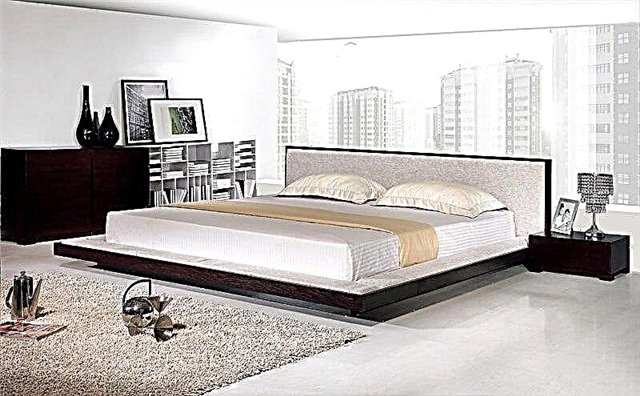
The floor in the bedroom is preferably made of natural wood, but for a worthy imitation, the option of a bamboo laminate is also suitable. The color of the floor matches the walls, only a darker shade is applied.

The ceiling in the interior of the bedroom in the Japanese style should give a feeling of weightlessness. The muffled stretch ceiling of one tone or frosted square glass framed by illumination around the perimeter of the room are ideal solutions to recreate the style of the Land of the Rising Sun.
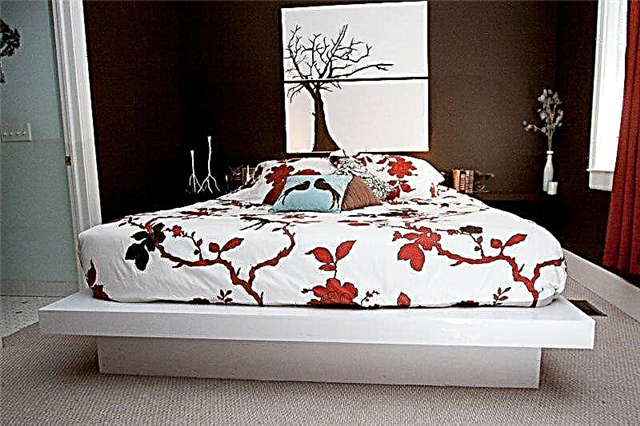
Lighting should not be bright and blind eyes - preference is given to soft and even dim shades, in which it is comparable to moonlight. For this reason, many sconces or floor lamps are used, the paintings on which also serve as a stylish decor for a very restrained bedroom.
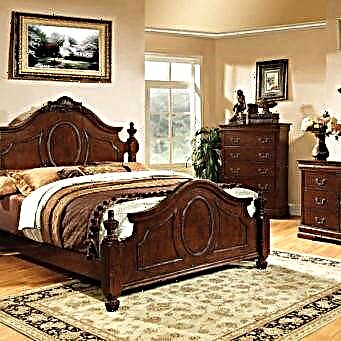
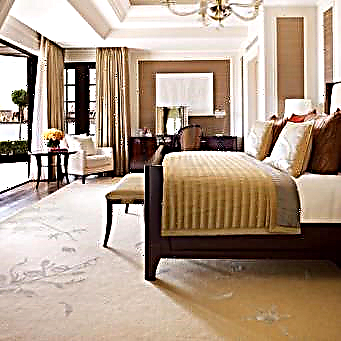
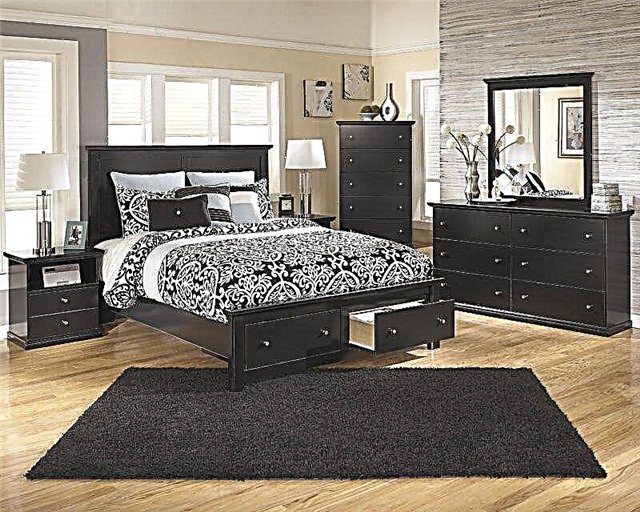
To give a characteristic atmosphere, special Japanese curtains are used in oriental-style bedrooms. They are narrow canvases in the form of protective screens that slide along the horizontal axis.
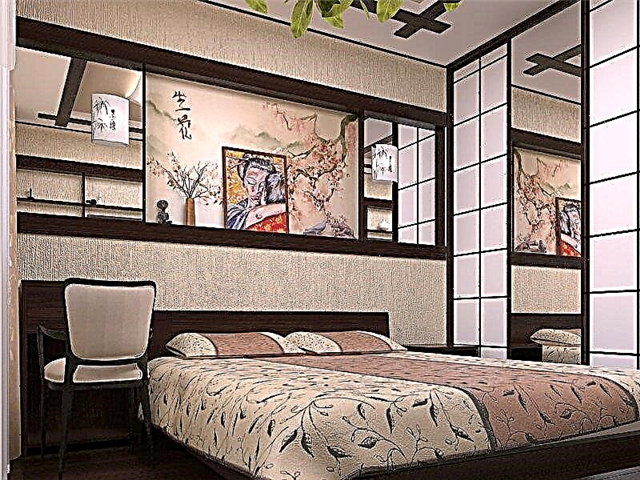
Features of furniture
The furniture in the Japanese bedroom is extremely simple and practical. There is no place for intricate designs and luxurious decorative details. A distinctive feature is the incredibly small height of the furniture.
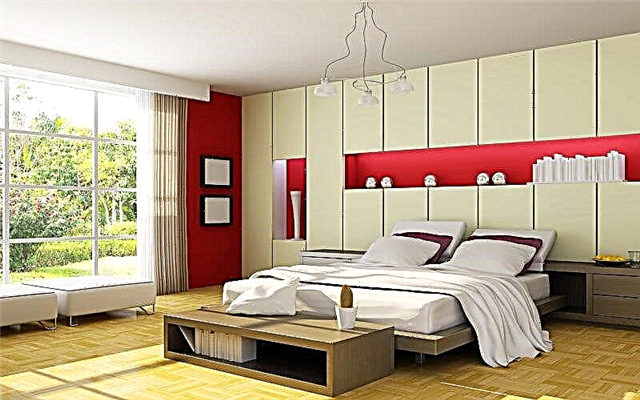
The bed should create the illusion that a person is simply on the floor, closer to the energy of the earth on which he steps. Japanese sleeping platforms are often used for this.
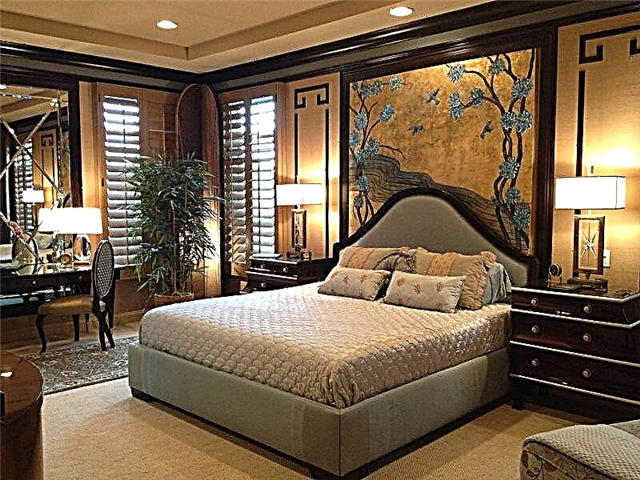
Nearby may be low bedside tables or glass tables. The Japanese themselves are sleeping on the tatami - this is due to the desire of the eastern peoples to complete unity with nature, even being in a civilization.
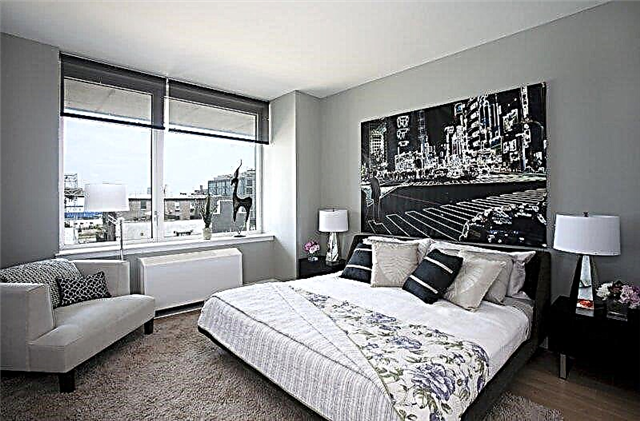
Wardrobes in the bedroom, of course, should be, but they are carefully hidden in the niches of the walls, equipped with sliding doors and do not attract attention.
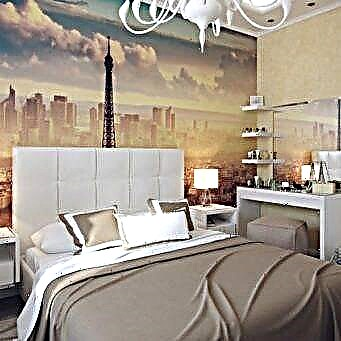
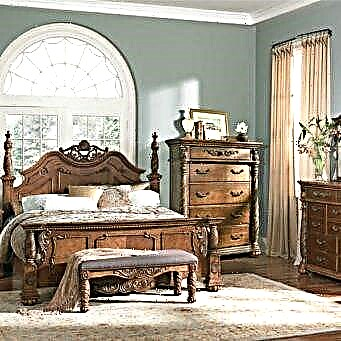
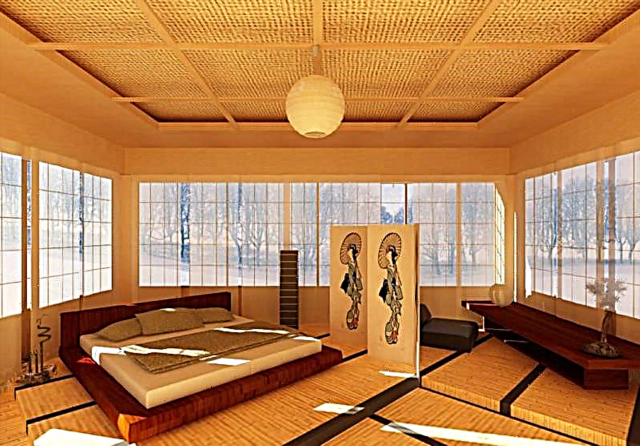
In the decoration of their bedrooms, the Japanese like to use retractable screens drawn by rice paper. In addition, an indispensable attribute of the eastern interior is a low table for tea ceremonies.
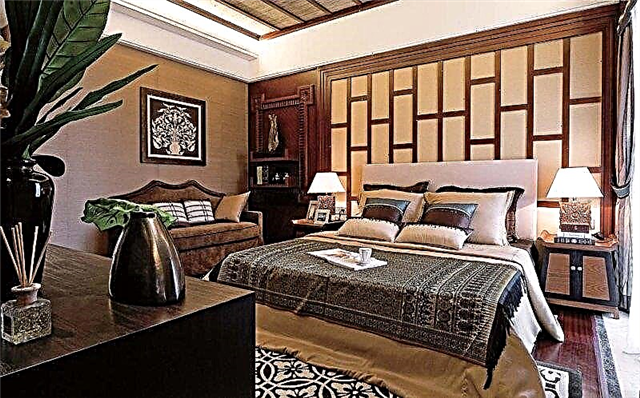
Japanese bedroom accessories
It is a mistake to believe that a commitment to minimalism precludes the possibility of complementing the room with interesting accessories. The main condition, the application of which is beautifully conveyed by the photo of the Japanese bedroom - any decoration should be appropriate, meet the general concept and carry meaning.

The Japanese interior encourages ornate ikebans, Buddhist figurines, floor vases with cranes or sakura branches. The Japanese nation gives a special role to the decorative bonsai trees in the house, the cultivation of which is part of their culture.
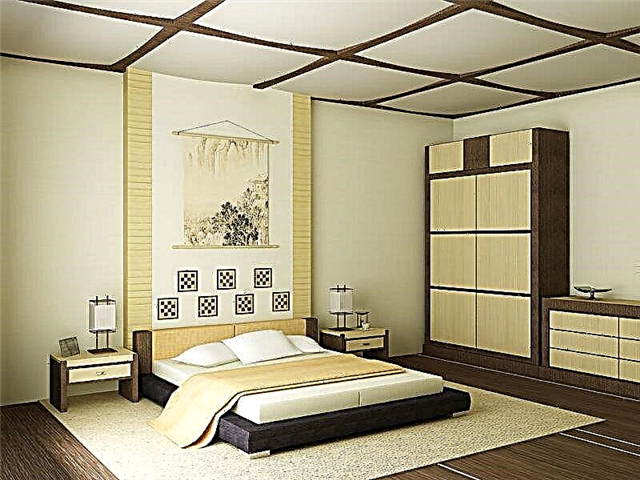
It is unusual for us, but it’s traditional for Japan to use kimono dolls, wall fans, samurai swords and daggers in the design of bedrooms.
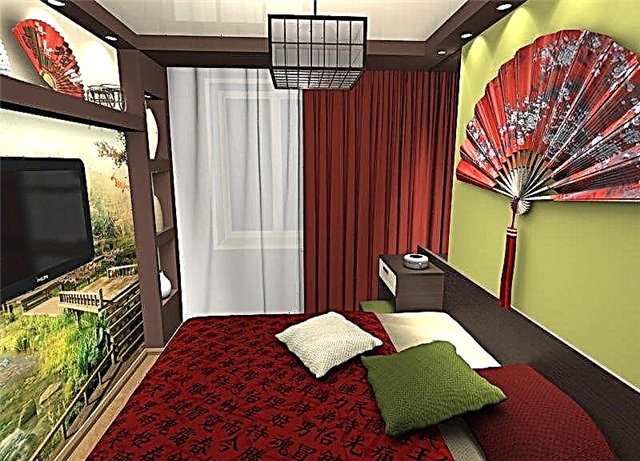
A discreet, laconic interior, in which order reigns in everything, a hint of natural purity is visible in every detail, where it is easy to breathe deeply and get a charge of indescribable vigor from it - these are the main advantages of a genuine Japanese bedroom.
Asian style features
It is possible to briefly outline the main criteria of the Japanese style in almost two words - tradition and minimalism. The laconic design and the lack of lush decorative additions is simply explained: Japan is a very small and densely populated country. This could not but leave its mark on the formation of the traditional oriental style in the design of the premises. This style is perfect for small-sized apartments, such as "Khrushchev".
The Japanese-style bedroom is designed with the following principles in mind:
- Minimalism. Free space, devoid of a large number of decorative ornaments and accessories, allows you to create the most optimal conditions for relaxation and rest after a hard day's work.
- Naturalness. The proximity of man to nature is strongly emphasized with the help of natural materials used in decoration and interior design (wood, natural silk, bamboo, linen, cotton). The color scheme should also be close to natural (brown, green, dark red).
- Functionality. Proper arrangement of furniture, shelves, cabinets allows you to perfectly place all the necessary things and save a lot of free space.
The Japanese style in the design is most suitable for people who are tired of the hectic life in the metropolis and striving for natural beauty and solitude. Such a style in the interior of the bedroom is recommended for connoisseurs of concise, simple design solutions.
Do-it-yourself room decoration options
Traditional Japanese housing is very different from European living quarters. There are no heavy and massive walls. Zoning of the room is carried out using mobile screen partitions made of thin rice paper. Today, such screens can be used to design a bedroom in oriental style or to divide a room into several separate corners, for example, for reading or sleeping.
For the design of the walls, materials are used, sustained in a light, dim color scheme. It can be:
- Wallpaper, for example, bamboo or textile. There may be a paper version, decorated with Japanese characters or traditional ornaments (sakura, cranes, fans),
- wooden panels (this design is very similar to traditional Japanese sliding partitions),
- textile,
- paint (painted walls can remain plain or they can be decorated with a stencil pattern).
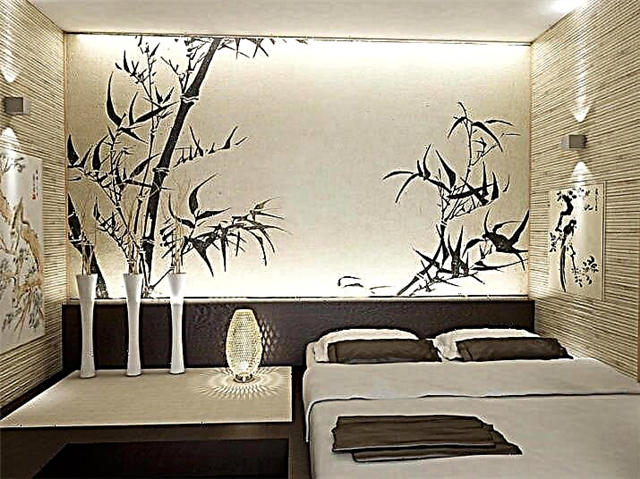
When decorating the ceiling, it is recommended to follow the following tips:
- Traditional Japanese architecture implies a square or rectangle shaped ceiling. (the same applies to elements complementing and decorating the ceiling).
- Materials can be both synthetic and natural origin. Of course, the second option is preferable (wood, fabric).
- Bright hues. Ceiling and wall coatings can be made in an identical color scheme, close to natural. As decoration of the ceiling, you can use light, restrained ornaments.
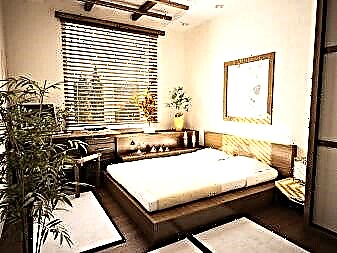
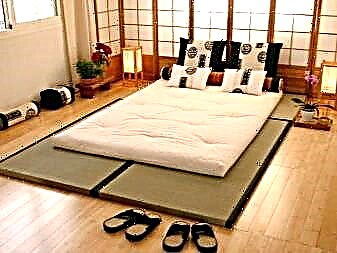
As a ceiling coating are used:
- beams (the ceiling is divided into regular rectangles using beams). They are simply attached to a painted ceiling or are additionally tightened with paper and cloth,
- stretch ceiling (can be glossy or matte, plain or decorated with delicate, discreet pattern),
- suspended ceiling (ideal if the ceiling profile is presented in a contrasting color with respect to the plates).
The arrangement and design of the floor in Japan is given a very serious and important value. One of the traditions of this country is walking barefoot, especially when it comes to the bedroom. The ideal option is a natural wood coating (parquet, laminate). Top you can add a bamboo mat, rattan fabric or matting. The disadvantage of these natural materials can be quite rapid wear, so instead of them it is quite possible to use a bedside mat decorated with oriental ornaments.
Features of the Japanese style in the interior of the bedroom
The striking differences in the Japanese style arose due to the living conditions on the Japanese islands that existed for thousands of years: sudden eruptions of volcanoes, tsunamis, landslides, typhoons and hurricanes.
Therefore, all the buildings in Japan were created so that people could survive in the wreckage of buildings and quickly build new buildings. It is with this that the attitude of the Japanese to various embellishments and decor is connected: if soon all this can die, do I need to acquire unnecessary things? In this case, a person seeks beauty in the surrounding nature, combining it with his home.

The striking differences in the Japanese style have arisen due to those living conditions on the Japanese islands that have existed for thousands of years
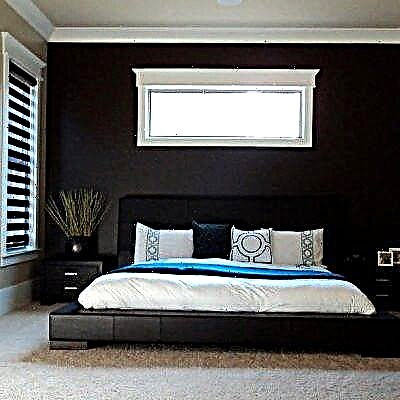
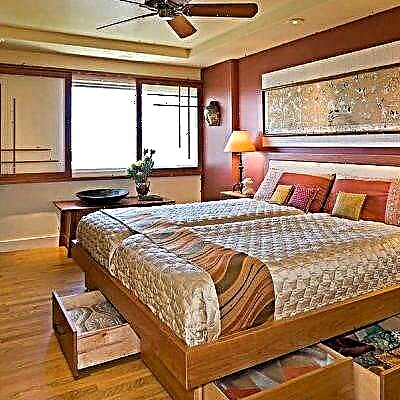
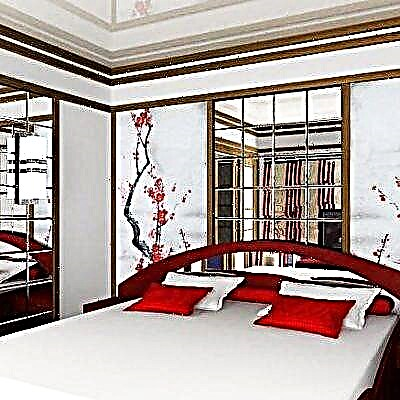
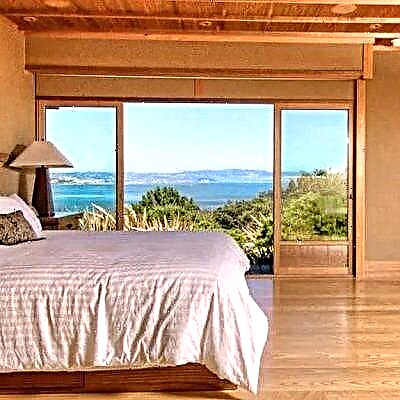
All these reasons led to the fact that the Japanese style is distinguished by such features:
- naturalness - natural materials and colors are used,
- functionality - living space is rationally organized,
- simplicity - the interior is filled only with the necessary objects of a laconic form.
To design a bedroom, such qualities in design are only welcome, allowing you to create a space where your eyes and thoughts rest, peace reigns.
Important! The Japanese interior is applicable for spacious rooms, but it also looks good in small apartments.
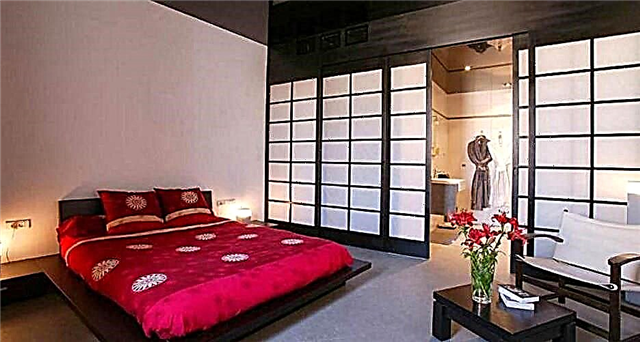
To design a bedroom, such qualities in design are only welcome, allowing you to create a space where your eyes and thoughts rest, peace reigns
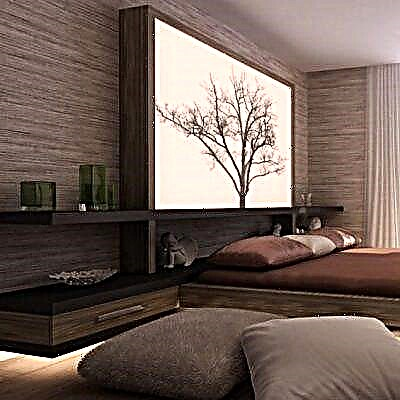
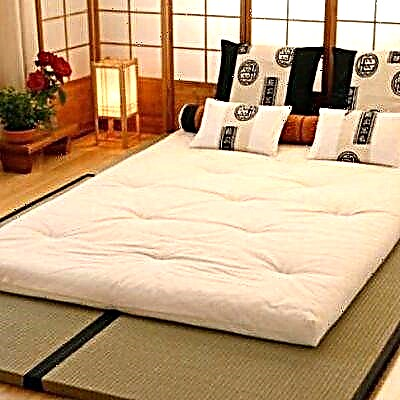
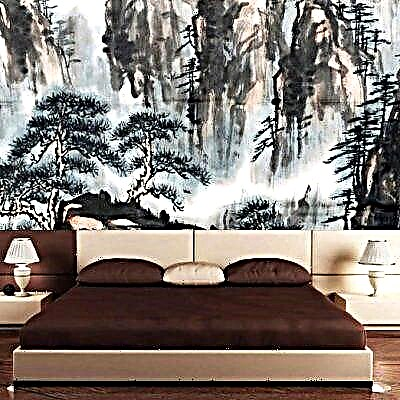
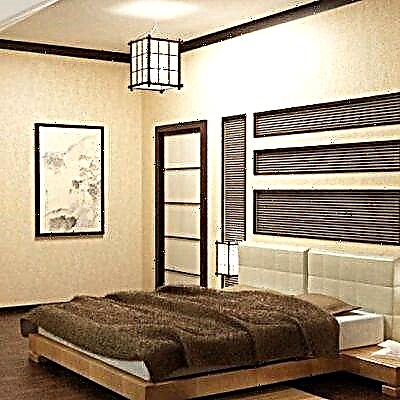
Design Features
Premises in Japanese homes have traditionally not had a clearly defined functional meaning. One spacious room with the help of lightweight partitions could be divided into the currently required compartments. Typically, two types of partitions were used:
- Fusuma - a sliding door that slides along grooves specially made in the floor, was made in the form of a wooden frame, covered with paper,
- shoji - an interior partition made of a wooden frame and paper covering it.
Also, folding screens and blinds were used for this.

Premises in Japanese homes have traditionally not had a clearly defined functional meaning.
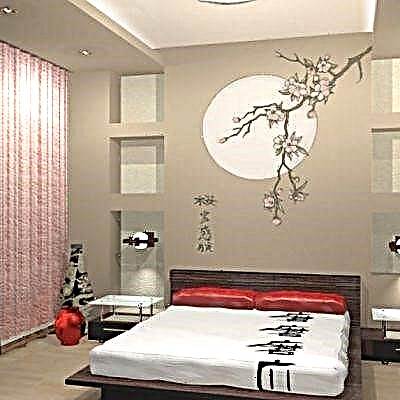
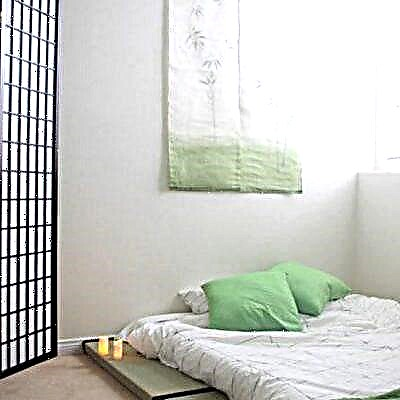
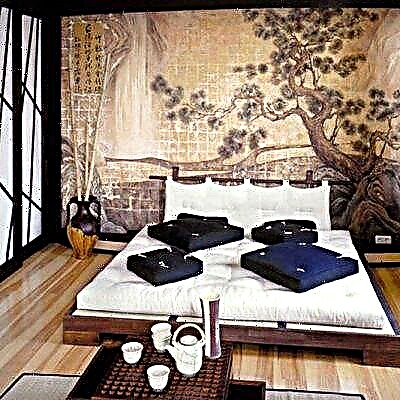
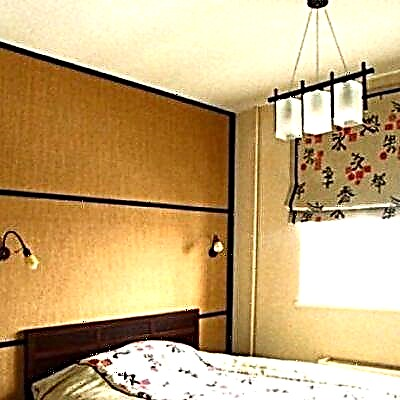
The main principle of the Japanese interior is the lightness and airiness of space. Therefore, all structural elements differ in that they do not take up much space and are mobile; they are easy to rearrange, changing the configuration of the room and the number of individual compartments.
Manufacturers offer a huge selection of screens, shoji and fusuma. The profile of partitions and doors is made of:
- cherry tree or red tree - these are elite expensive options,
- veneered or laminated material,
- steel, decorated with wood-like film,
- high quality plastic
- aluminum.
Transparent and translucent inserts are made of plastic, glass and, of course, special paper. Often they are decorated with images of animals, landscapes, hieroglyphs.
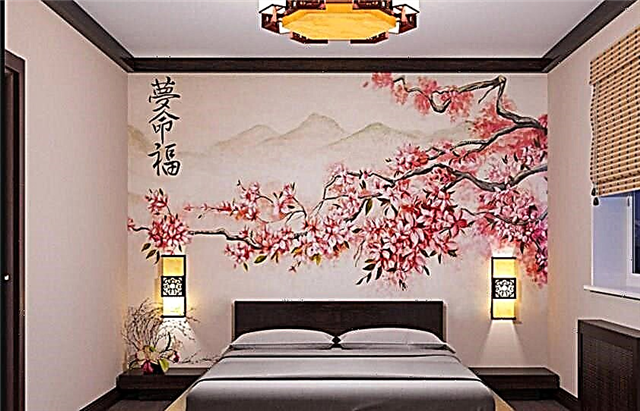
The main principle of the Japanese interior is lightness and airiness of space

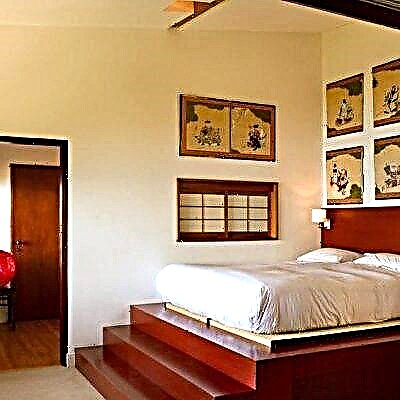

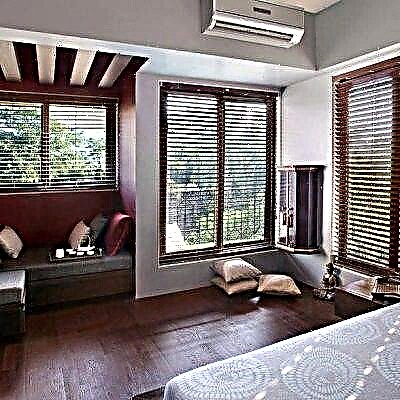
The shape of all partitions is unchanged for many centuries: the canvas is divided by jumpers into rectangles or squares where light-transmitting elements are inserted. Without partitions and screens it is difficult to imagine the Japanese interior.
Attention! The Japanese bedroom does not require the fundamental changes that are necessary to create some other ethnic styles. The only thing that does not hurt, but only gives the room an additional zest, is a niche.
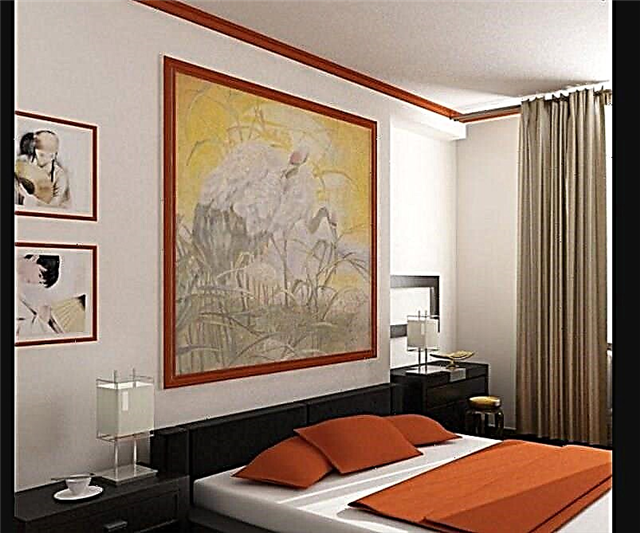
Niches play a big role in Japanese life. They have documents of family value.

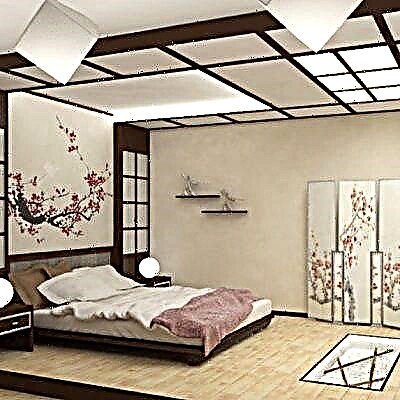
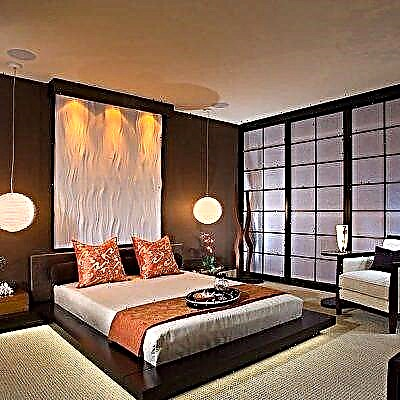
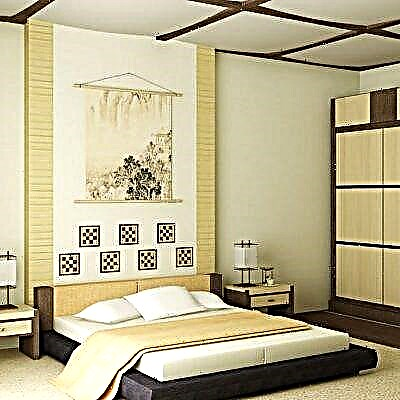
Niches play a big role in Japanese life. They contain documents of family value, scrolls with wise sayings or a beautifully written poem, and finally they are decorated with ikebans or statues of gods. Typically, niches are made shallow, up to 20-30 cm, height and width can be different.
Japanese-Style Bedroom Design: Nuances
Important! To make a bedroom in the style of the Land of the Rising Sun, it is not necessary to spend huge amounts of money. The taste and understanding of Japanese philosophy of life allow this to be done with the help of insignificant investments, a few tips in the article will help.
- Color palette. In the photo, the Japanese-style bedroom seems peaceful and concise. This is achieved through the use of natural shades in the interior, and light warm colors:
- beige, milk, cream, ivory,
- brown,
- cherry,
- grey,
- bamboo, grassy.
It is customary to use no more than 2 colors in the interior.

To emphasize the unity of opposites inherent in our world, the color scheme is combined from different colors
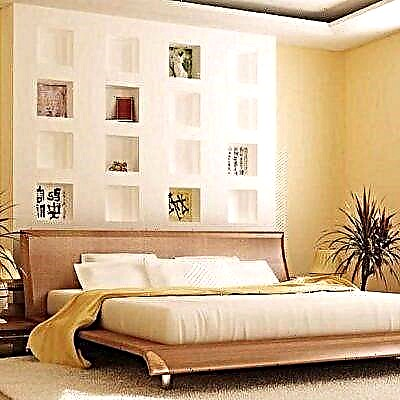

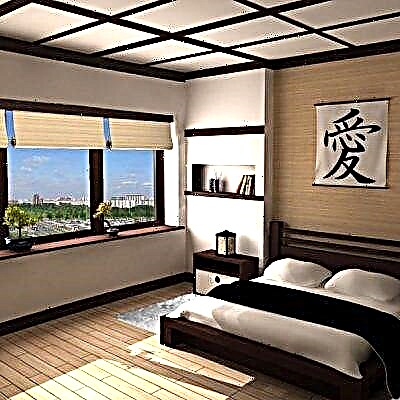

To emphasize the unity of opposites inherent in our world, the color scheme is combined from different colors, for example, black or cherry, brown with beige, grass are combined with white.
- Floor decoration. In the classic version, the floors should be wooden, made of solid cedar or maple. In modern conditions, expensive wood can be replaced with high-quality imitating materials:
- laminate flooring
- linoleum.
For zoning the toilet room, which, according to Japanese ideas, should be moved outside the living space, designers suggest using river pebbles, from which the path to the bathroom or the floor is laid out.
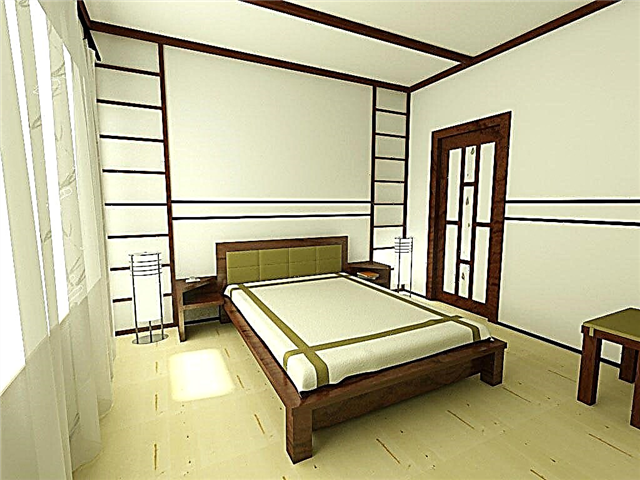
In the classic version, the floors should be wooden, made of solid cedar or maple
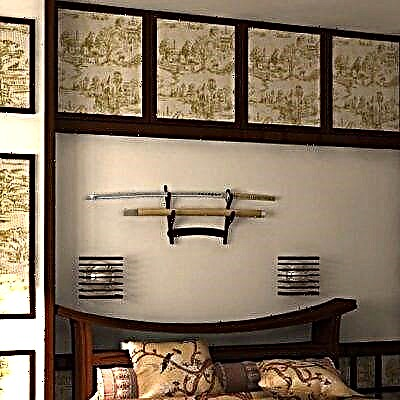
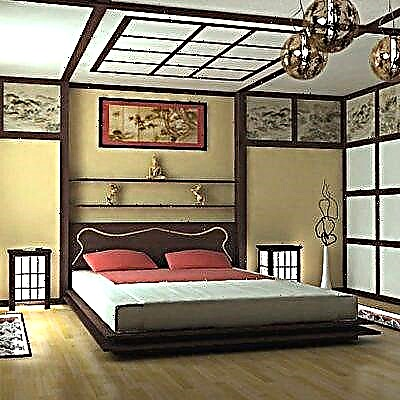
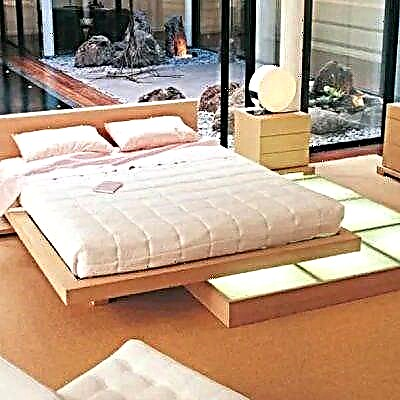
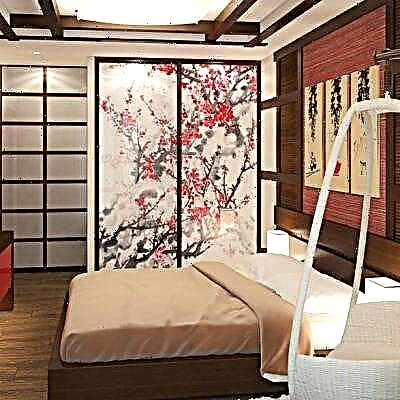
And one more necessary element - tatami. They usually measure the area of a Japanese house, the size of one is 1.5 m2.
Tatami are thick square mats. Each mat is three straw mats sewn together. Golden, pleasantly smelling tatami completely cover the floors, they are never stepped on with shod legs. However, in a modern European house, you can successfully replace the tatami with carpet-colored natural products, lay mats or leave the floors without decor.

In a modern European house, you can successfully replace tatami with carpet-colored natural products that are matched to color, lay mats or leave floors without decor

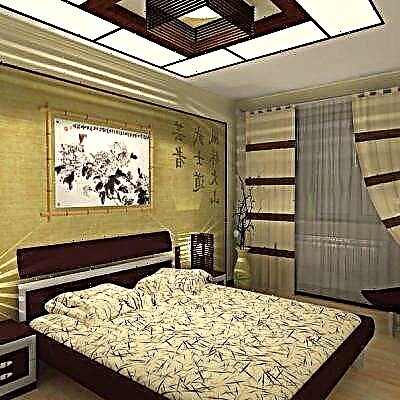


- The decoration of the walls. The interior of the bedroom in the Japanese style looks calm and neutral, the photo can be viewed below, since materials without a pronounced texture are used for the walls. Priority colors are light. To create a style, you can use:
- wallpaper, bamboo or paper, well imitating rice paper, silk fabric,
- wood panels giving the impression of sliding doors or partitions with translucent inserts,
- paint - one-color painting gives the impression of a concise space, moreover, it is a cost-effective option,
- fabric - natural silk, cotton or bamboo fabric of soft colors will perfectly fit into the interior.

Do not get involved in drawing hieroglyphs or drawings on the Japanese theme on the walls
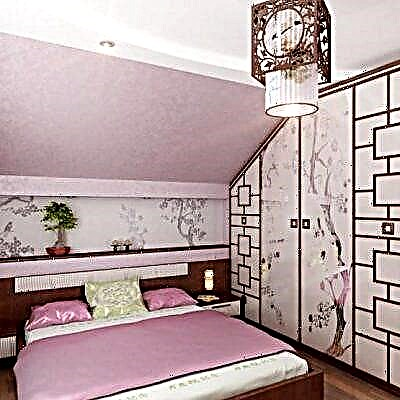

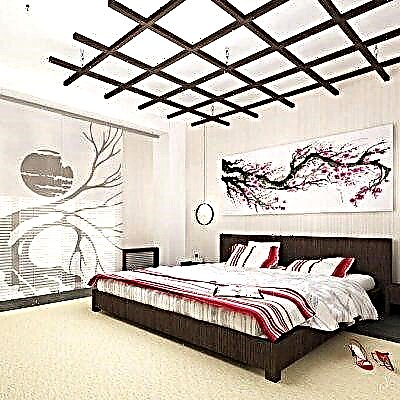

Do not get involved in drawing hieroglyphs or drawings on the Japanese theme on the walls. In general, the bedroom should leave an impression of free space without emotional details.
- The decoration of the ceiling. In the tradition of the inhabitants of the Japanese islands, paint is matched to the ceiling to match the wall covering. Designers offer the following options for decorating the ceiling in the bedroom:
- simple coloring
- PVC film
- the ceiling using beams is divided into squares or rectangles, the beams can be wooden or plastic.
In the latter case, the beams are selected contrasting floor and wall color. It should be noted that cells created in this way will visually reduce the height of the room, therefore this option is suitable only if the ceiling height in the bedroom exceeds 3 m.

In the tradition of the inhabitants of the Japanese islands, paint is matched to the ceiling to match the wall covering.
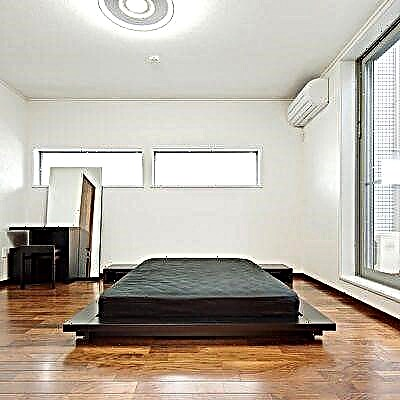
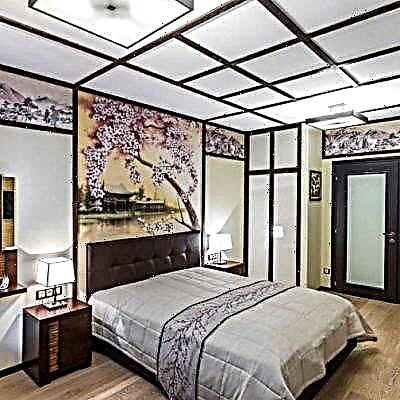
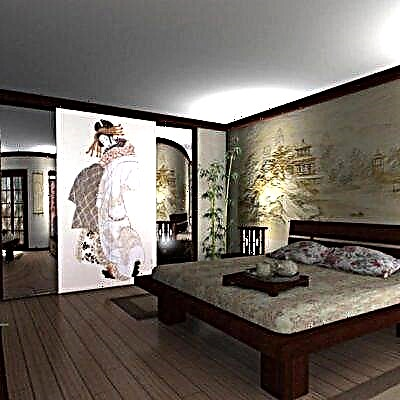
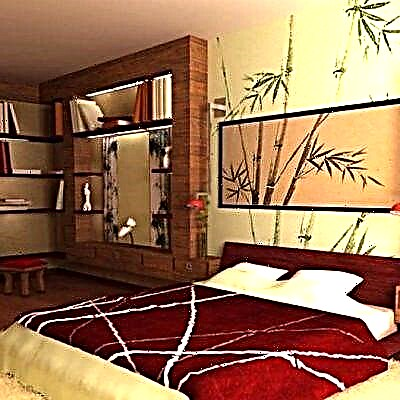
- Lighting. Europeans and Japanese have a different understanding of how a house should be lit. In Japanese, the light should be unobtrusive, unsharp, fill the room naturally. This is facilitated by matte inserts on the doors, the arrangement of lighting fixtures and special lampshades.
As lighting devices in the bedroom, you can use:
- built-in ceiling lights with the ability to adjust the degree of illumination,
- a central chandelier made of traditional materials - rice paper, fabric, bamboo,
- Floor or table lamps, as well as sconces are not welcome.
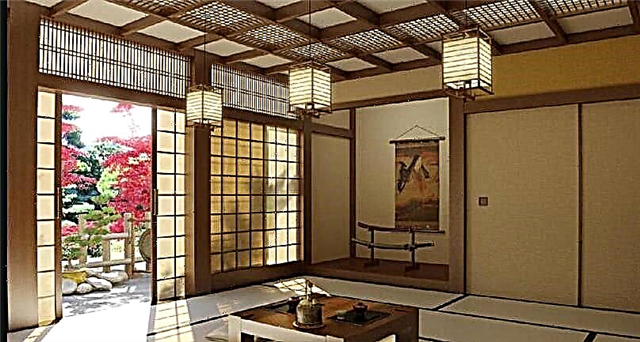
In Japanese, the light should be unobtrusive, unsharp, fill the room naturally
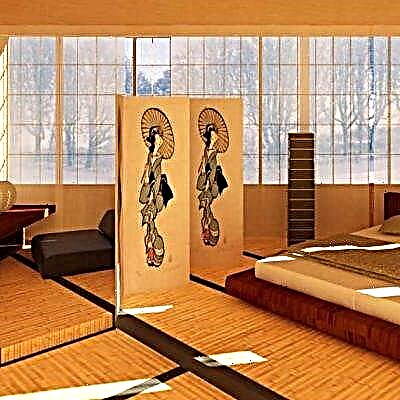
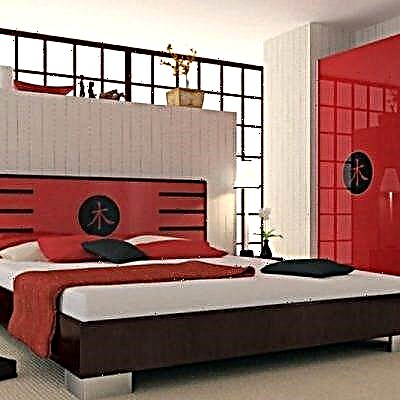

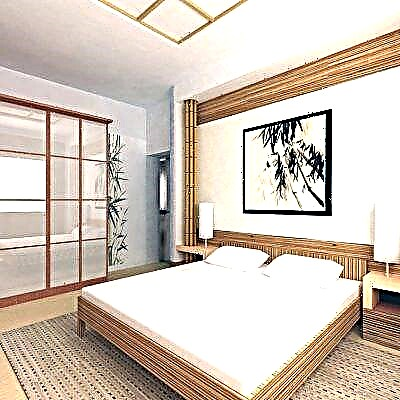
It is necessary to select lighting devices in white, black, brown, with frosted bulbs.
Of particular importance are lampshades. Akari, a metal structure and a rice paper lampshade, has been around for 150 years. Such lamps scatter bright light, creating a pleasant relaxing twilight. Can be used on lamps and simple paper lampshades.
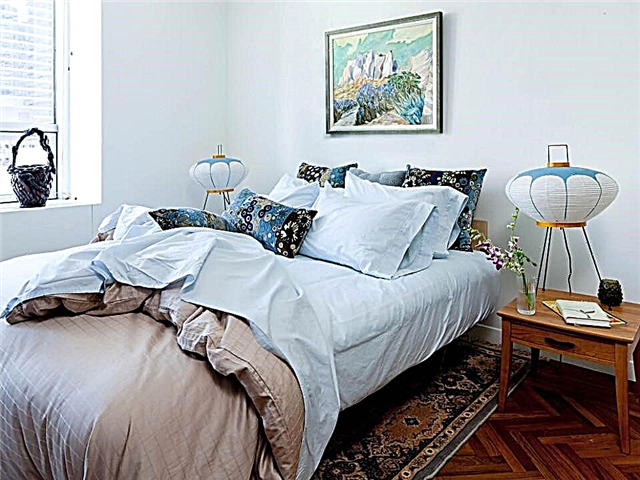
Akari - a metal structure and a rice paper lampshade - has been around for 150 years
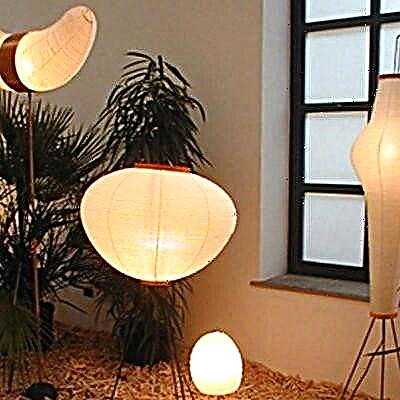

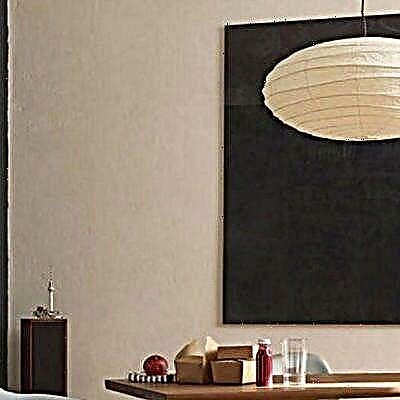
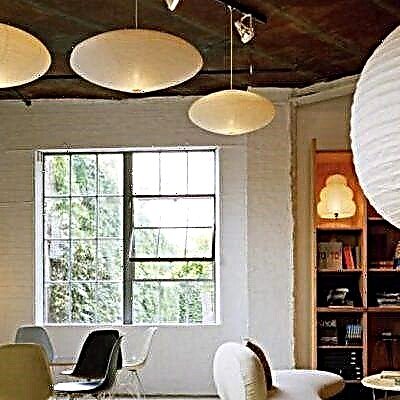
Furniture selection
In the proposed photos, the design of the bedroom in the Japanese style is supported by correctly selected furniture products. What features distinguish furniture that is suitable for the interior in the Japanese style:
- low
- has the shape of a horizontally elongated rectangle or square,
- without decorative elements on the facades,
- handles are either geometrically regular or missing,
- on low strong legs,
- made of wood.
According to Japanese tradition, it is customary to sleep directly on the floor on a special mattress stuffed with cotton - futon. In the afternoon, the futon cleans up in the closet.
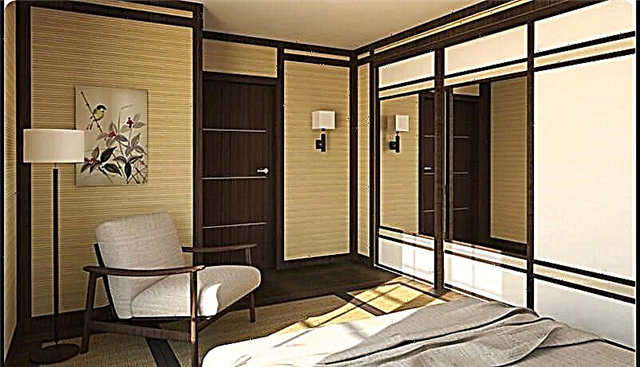
In the proposed photos, the design of the bedroom in the Japanese style is supported by correctly selected furniture products
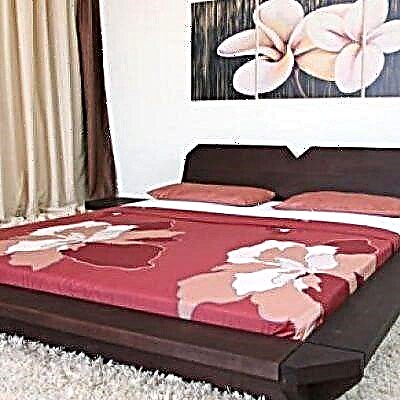
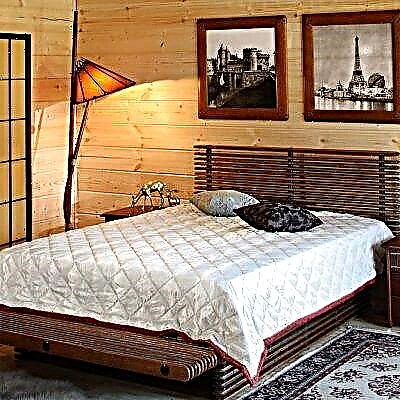
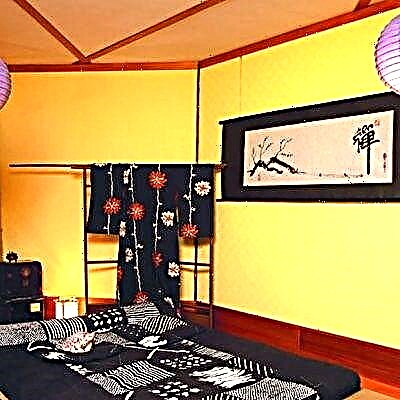
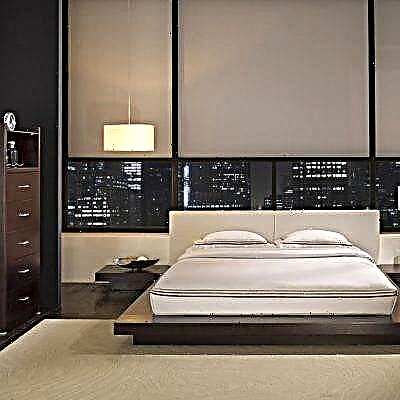
In a modern apartment, you can replace the futon with a low wide bed by placing it in the center of the room where the most favorable energy flows intersect.
An excellent solution would be to install a bed on a special low podium, which at the same time will serve as a place to store things. To do this, it is necessary to equip it with a system of retractable modules.
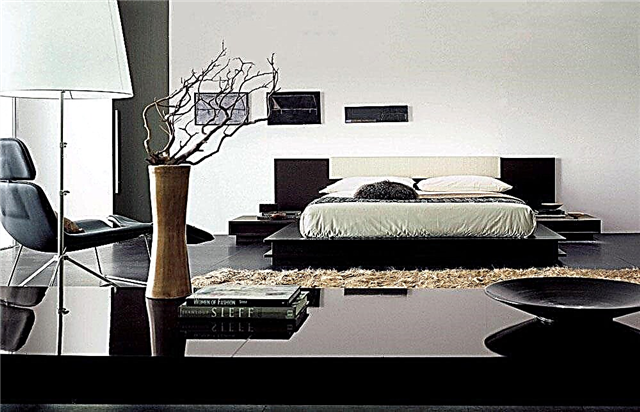
An excellent solution would be to install a bed on a special low podium, which at the same time will serve as a place to store things
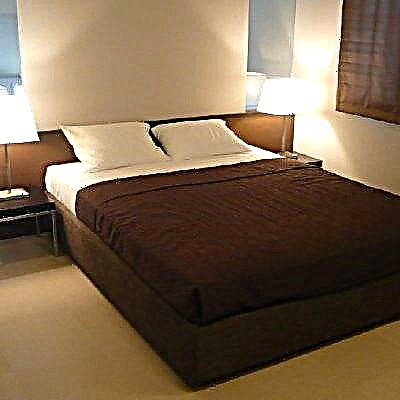
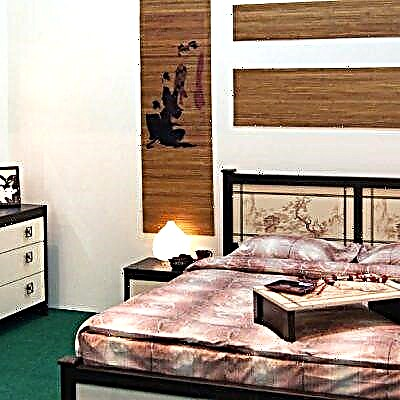
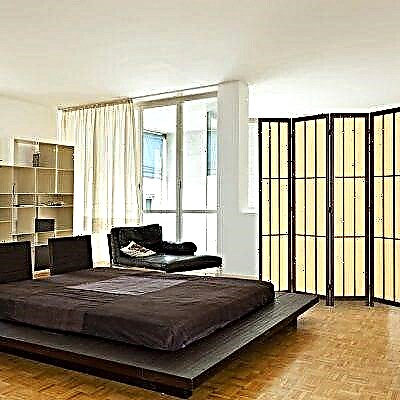
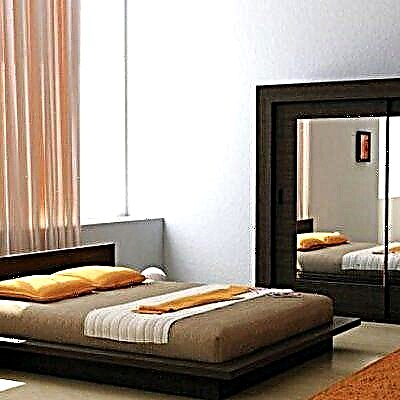
Bedside tables should also fit into the interior, which means that they should be wooden, low, without numerous shelves.
Wardrobes and wardrobes are unacceptable in the Japanese style. All things must be cleaned either in the wardrobe, the doors of which are stylized as walls or doors, or in niches. Even better is to allocate a special room for storing clothes.
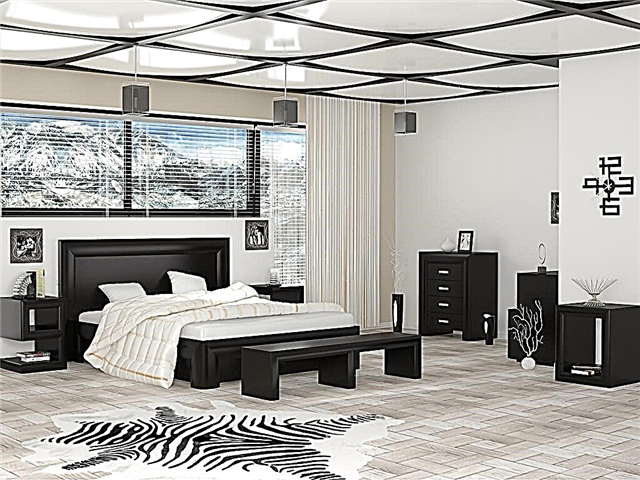
Japanese-style wardrobes and wardrobes are unacceptable
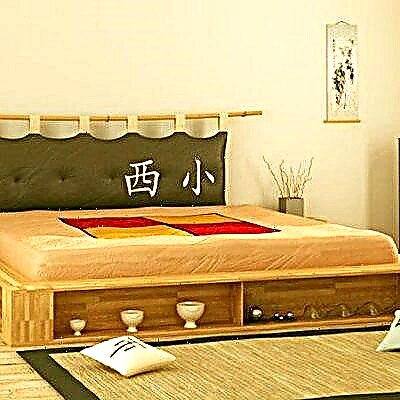
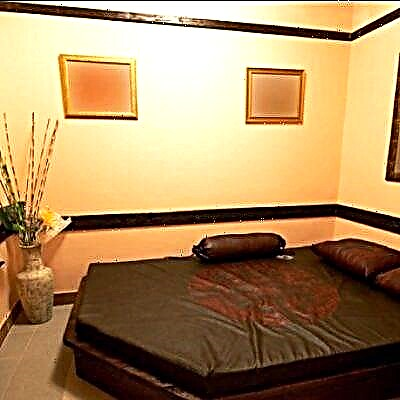
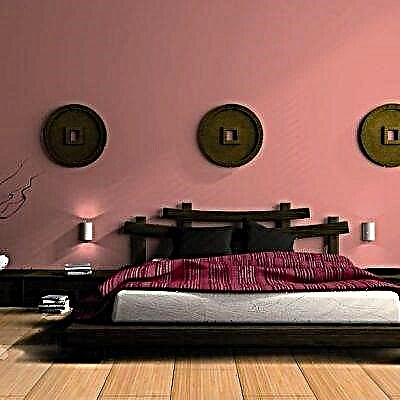

Japanese-style textiles and curtains in the bedroom
Curtains give a bedroom a cosiness, therefore their presence is necessary. The best option is Japanese fabric panels. They are made of light transparent or translucent materials, such as linen or cotton, as well as bamboo, jute, rice straw. It is best to choose plain fabrics of light colors, this will soften the sunlight pouring into the windows.
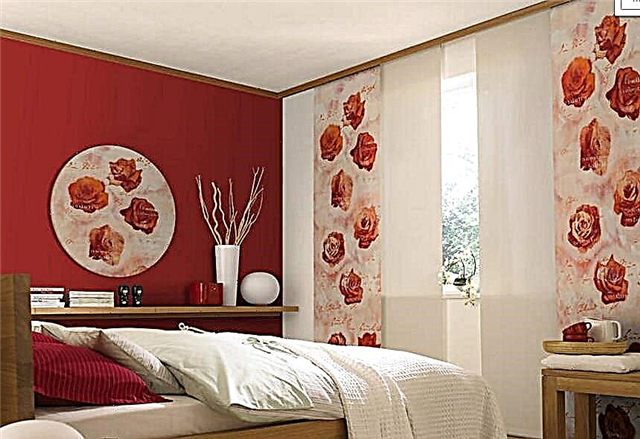
Curtains give a bedroom a cosiness, therefore their presence is necessary
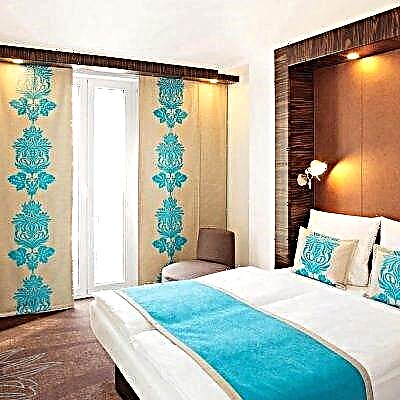

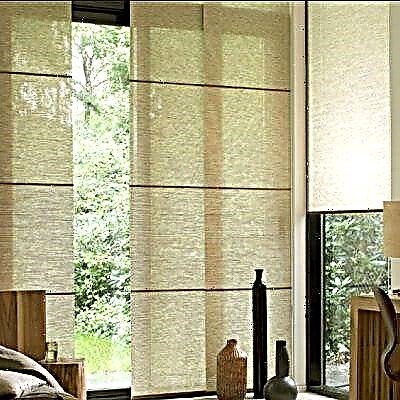

The design of the curtains is simple: on a special ledge there are several rails to which fabric panels, weighted from below, are attached. Such curtains move horizontally, cleaning each other.
If the windows are narrow or inconveniently located, bamboo horizontal or vertical fabric blinds, as well as fabric blinds, can be hung on the windows.
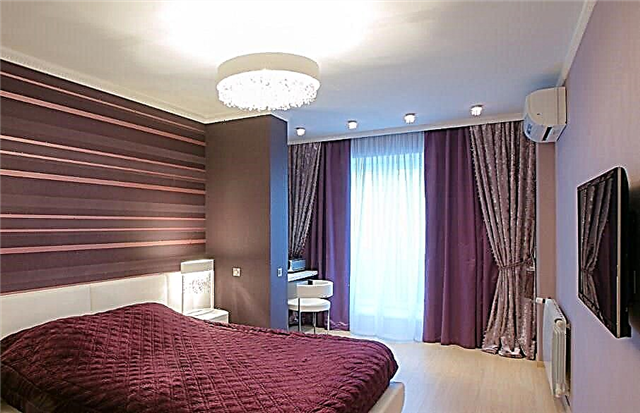
Decorating a Japanese-style bedroom with your own hands, photos of possible options are given in the article, do not forget about other textiles


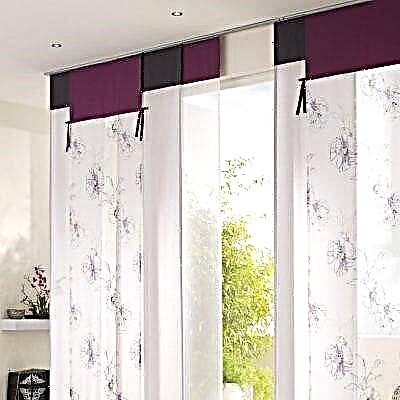
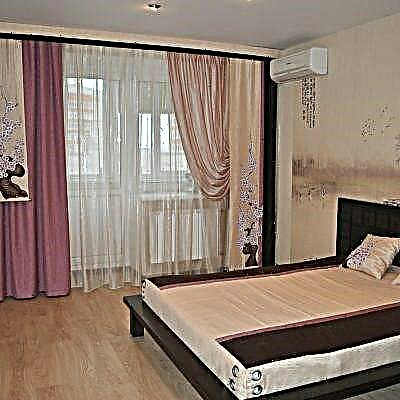
Decorating a Japanese-style bedroom with your own hands, photos of possible options are given in the article, do not forget about other textiles. Choosing a carpet, it is worth choosing the products that imitate tatami and look like mats or are made of natural materials (jute, raffia, straw, sisal).
Advice! Bed linens and bedspreads are matched in tone or contrasting color to the walls.
Several pillows on the seating floor complete the interior. Pillows are made from natural fabrics - cotton, linen, suede.
Japanese style accessories
Laconicism and restraint of the interior in the Japanese style still do not reject the presence of decorative elements. The main requirement is a minimum quantity with high quality and relevance. For bedroom decoration fit:
- bonsai
- ikebana,
- a vase with an interestingly curved branch,
- figurines
- scrolls of calligraphic poems
- engravings in a thin wooden baguette,
- fans.

Laconicism and restraint of the interior in the Japanese style still do not reject the presence of decorative elements


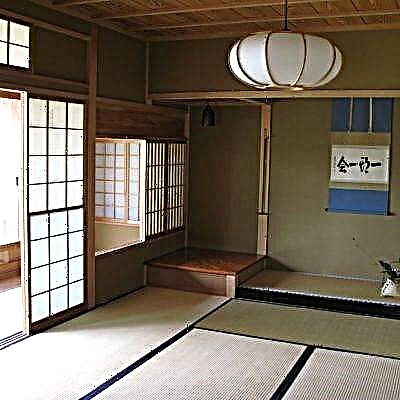
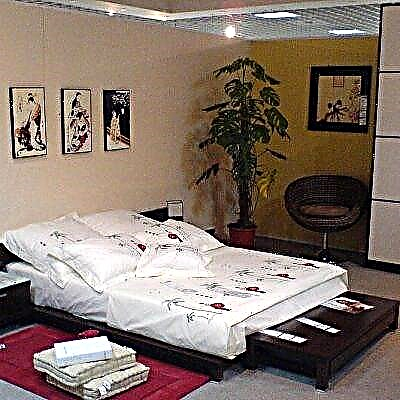
1-2 decorative objects do not overload the space and at the same time add originality and exclusivity to the interior solution.
Japanese style features
The decoration of interiors with an oriental theme has several directions, somewhat similar, but, to a greater extent, significantly different from each other. The Japanese style stands out radically due to its originality. The features of the direction include the following indicators:
1. Minimalism - there is no place for clutter, lush scenery and luxury. Maximum free space where vital items are located. This is partly due to frequent natural disasters on the islands, leading to the destruction of residential buildings. The Japanese do not seek to equip their lives with excessive pretentiousness.
2. Naturalness - natural materials prevail in the arrangement and decoration, although in some cases their imitation is also possible. The same applies to the color palette, close to natural shades.
3. Lightness and airiness of the environment - interior elements are usually small and mobile, and the presence of movable screen partitions allows you to easily change the configuration of the room.
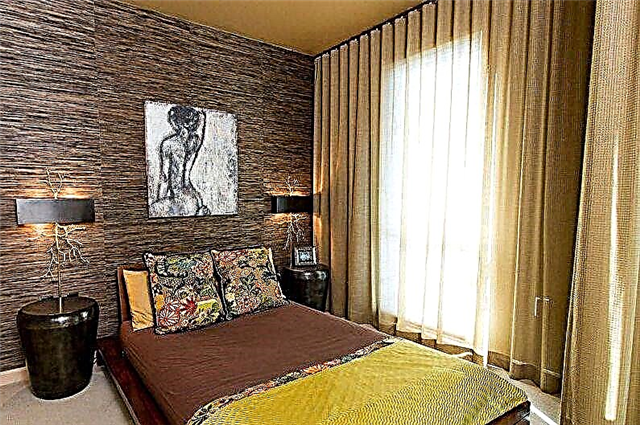
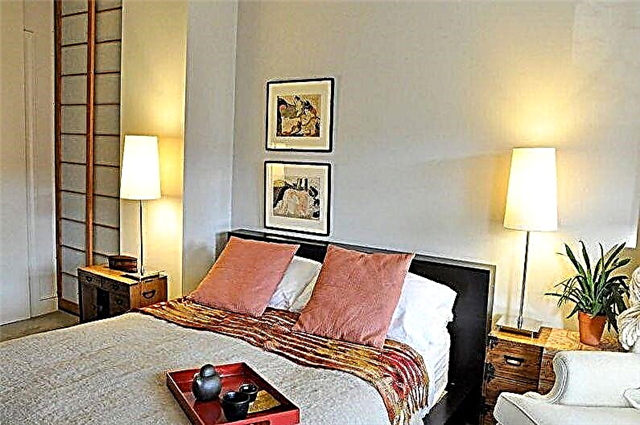
Color schemes
Most often, Japanese-style bedrooms are decorated in bright colors - this way the atmosphere of peace and tranquility necessary for this room is achieved. Used palettes of beige, cream, milk, gray, grass tones. To dilute the uniformity allow brown, cherry, black paint. The interior uses no more than three colors, one of which is the background.
Japanese-style black and white bedroom
White and black palette is often found in interiors of oriental directions. It is traditional, reflecting the eternal desire of philosophers to find a balance between masculine and feminine, earth and air.
White walls with black hieroglyphs and a carpet “under a zebra” look great here. You can draw in black colors one of the walls of the room, for example, at the head of the bed, against which white low bedside tables will contrast.
More daring decisions come down to black decoration of the ceiling surface, which turns into white walls and gray floor. This combination can be complemented by the beige shades present in the floor finish, partition walls and decor.
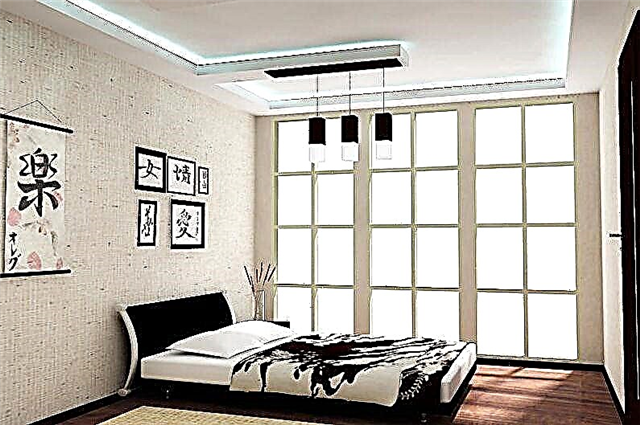
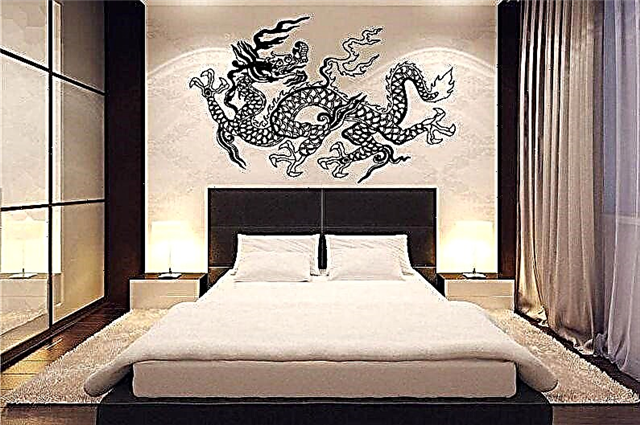
Japanese-style beige bedroom
The interior of the bedroom in beige colors is light and elegant. He is able to give a calm sleep and complete peace, presenting a natural palette of tones - just what you need in this direction. Originally painted walls look with smooth transitions from light beige to dark. The walls can be decorated in a darker palette than the ceiling and floor - this makes a special geometric diversity.
Naturally, this beige color cannot be present on its own, otherwise the room will turn into a closed box. Accompanying tones will be brown, cream, white, ivory. It will be beneficial to look at bamboo paintings on the walls and similar curtains, textiles and furniture in brown tones, the design of a dull matte ceiling.
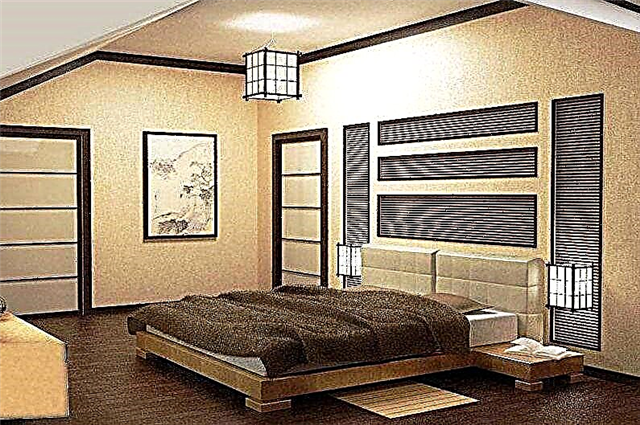

Japanese-style red bedroom
The color of ripe cherries also has a place in the East Japanese interior. The main task is to determine its quantity. For those who adhere to strictness and conciseness, you can make the main background of the walls and ceiling white, the floor in light beige or gray colors, and a red palette will be present in one of the wall panels, textiles, lamp shades. The priority of beige shades as the main ones will contribute to a calm sleep and rest, and cherry shades will become insignificant accent additions.
The design of the bedroom for passionate natures allows you to fully fill it with red. It is desirable that the walls are not monophonic - you can use wallpaper with a Japanese ornament, graphic images of a darker or lighter cherry palette. The ceiling can be left light - artificial lighting will give it the desired pinkish tint. Black furniture will look great here.
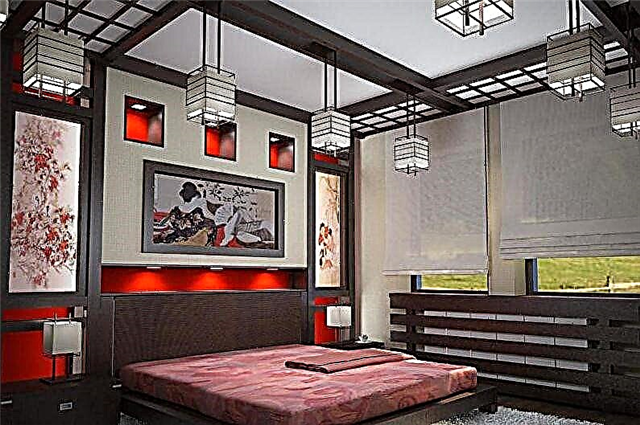

Finishing and materials
Since Eastern philosophy considers living quarters to be an animated subject, decoration materials must be of natural origin. But, given the high cost, inaccessibility and impracticality of some of them, the presence of artificial substitutes is quite acceptable.
It is customary for the Japanese to walk barefoot at home, so when choosing a floor covering, wood will be preferred. It can be replaced with parquet or bamboo laminate. Ceramic large monophonic tiles may also be present, but since this material is quite cold, it will be necessary to equip a “warm floor” or use a plain palace.
The original design implies the presence on the floor of a tatami made of rattan or bamboo, but since they wash out pretty quickly, they are often replaced with rugs with drawings of Japanese themes or neutral colors.
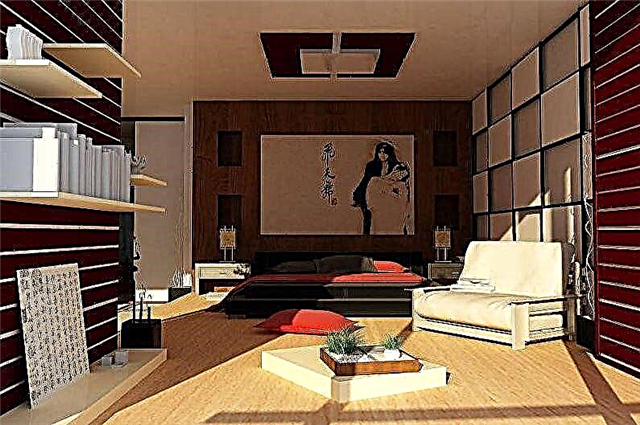
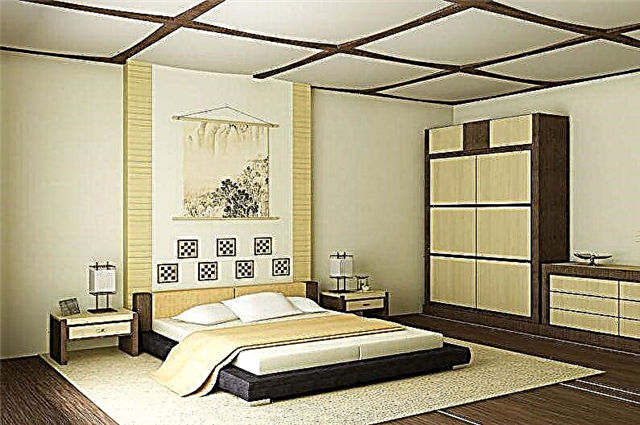
Walls
The walls decorated with fabric will look stylish and comfortable in the Japanese bedroom. Wooden panels imitating sliding partitions also look great. Simpler options are plastering, painting the walls with the application of traditional patterns, wallpapering. Ethnic patterns, for example, blooming sakura or hieroglyphs, are appropriate on paper wallpaper. The best way to support the style will help bamboo canvases. Designers advise choosing pastel colors without a riot of colors, limiting themselves to one or two colors for decoration. Although dark options are not excluded, and walls in red light are quite common.
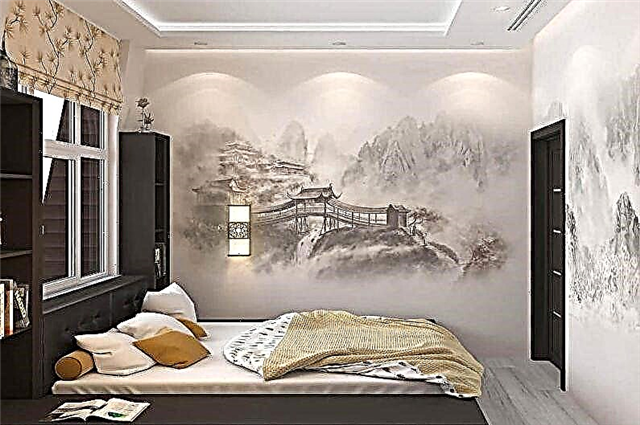

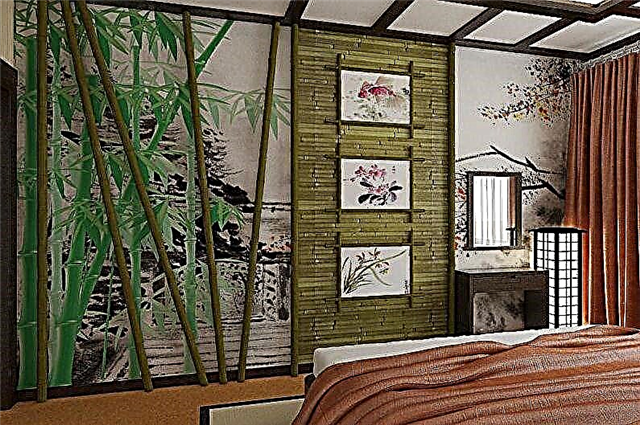
Ceiling
The first thing to note in the design of the ceiling surface is the use of natural materials, a rectangular shape and cladding in bright colors. There are several surface finishes. Often used is the reception of equipment for beam structures that divide the plane into squares or rectangles. The space between them is painted or covered with white cloth, rice paper.
The Armstrong system with beams and decorative plates looks similar and looks no less impressive. And there is one trick - the larger the cell, the wider the ceiling will seem. Another option is to decorate the ceiling with a stretch film or cloth.
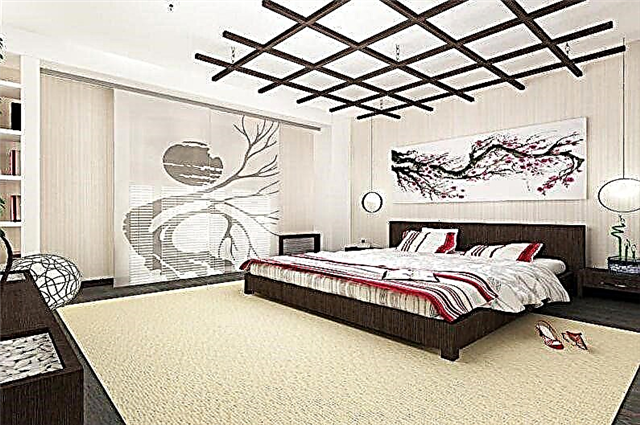

Japanese-style bedroom furniture
The furniture of the lounge is minimal. However, this applies not only to bedrooms, but also to the rest of the premises of East Japanese apartments. This is explained by the densely populated country where every square meter counts and acutely lack of living space.
The bed is the central element. It should have a squat rectangular shape, located almost on the floor like a Japanese futon mattress. Add original notes will help placing it on the podium with steps. Bulky storage systems are replaced with wall-mounted niche-type wardrobes with Japanese-style sliding doors. The interior will be supplemented by bedside tables, a tea table, and small shelves for trinkets.
If the room is quite large, you can divide it into zones using your favorite national sliding partitions. They are wooden frames with frosted white glass and perpendicular planks dividing the canvas into squares or rectangles. The door of the room should be the same.
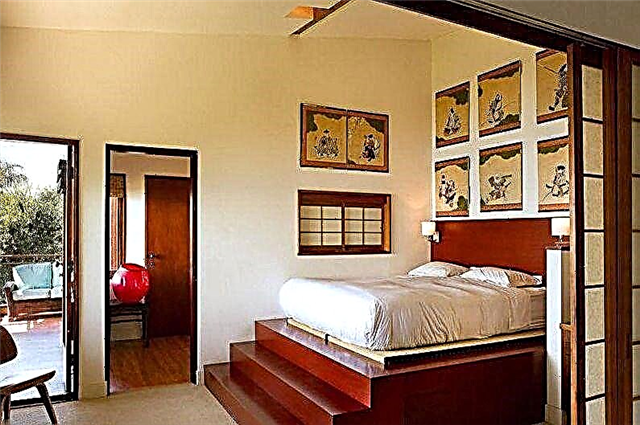
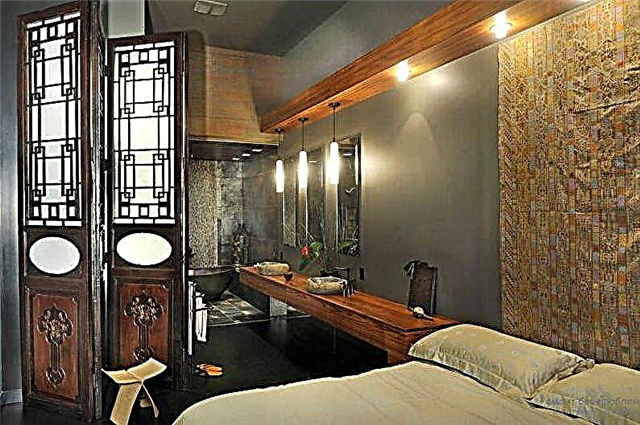
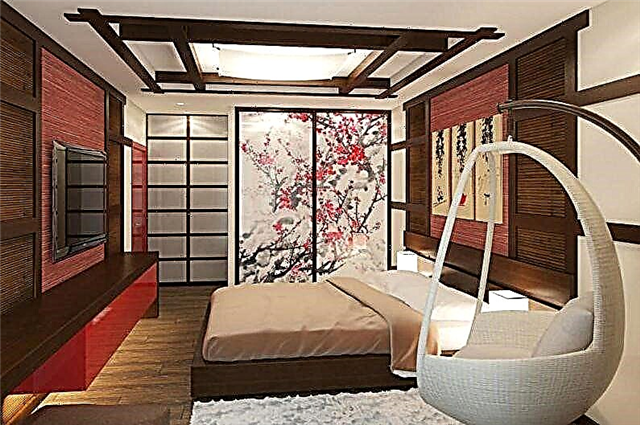
Decor and lighting
In the room intended for rest, bright lighting is not required. Subdued light will create the necessary atmosphere of mystery, contributing to complete relaxation. Lamps have simple geometric shapes, made of glass, rice paper, bamboo or fabric. If the bedroom is small, you can use spotlights for the ceiling. Floor lamps and wall lights are less commonly used, but, made in national traditions, they will become a decoration of the room.
You need to decorate the bedroom in the Japanese style carefully, without loading the space. You can install a floor vase with a national ornament, which will accommodate twigs of bamboo or ikebana, on the shelves arrange traditional figurines, scented candles, a bonsai tree.
The walls will be decorated with national fans (they often crown the head of the bed), samurai swords, parchments with hieroglyphs. In the latter case, you need to be extremely careful - before you place the image of the hieroglyph in the interior, you need to find out its meaning.

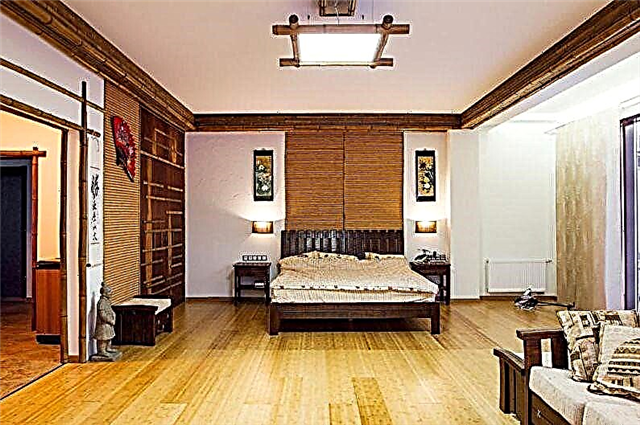
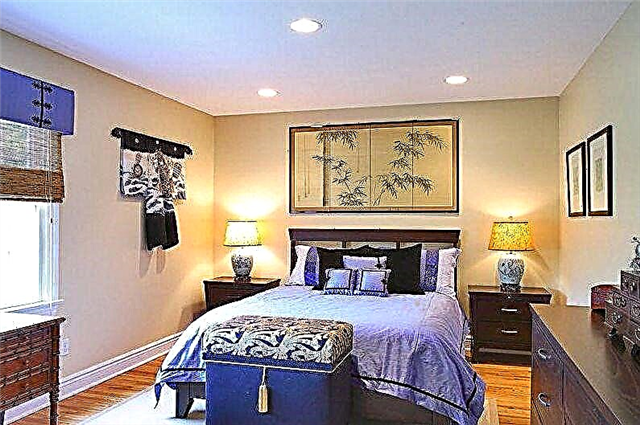
Japanese-style small bedroom
Since the design of the life of the country of the rising sun implies strict conciseness, this is ideal for small rooms. Low furniture and its minimal amount will leave a lot of free space. The mattress bed can be placed on the podium, in which drawers for storing various things will be located. In the niche of one of the walls, you can equip a small locker for clothes, disguising it as a “shoji” partition, favorite by the Japanese. It is better to design a room in light beige, milk colors. The accents will be minor black, cherry decor elements.
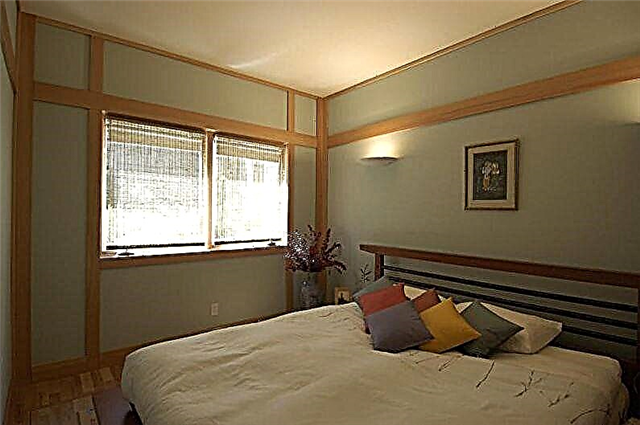


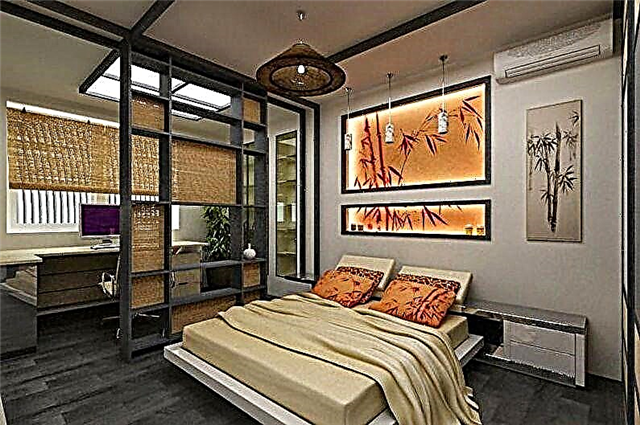
Japanese-Style Bedroom Design - Photo
A selection of photographs will help to fill your imagination with the spirit of Far Eastern identity and truly stylishly decorate the bedroom interior. Here are various design options in true Japanese style or more Europeanized. Choose what is closer to your perception, understanding of the beautiful, and feel free to experiment. Enjoy watching!


